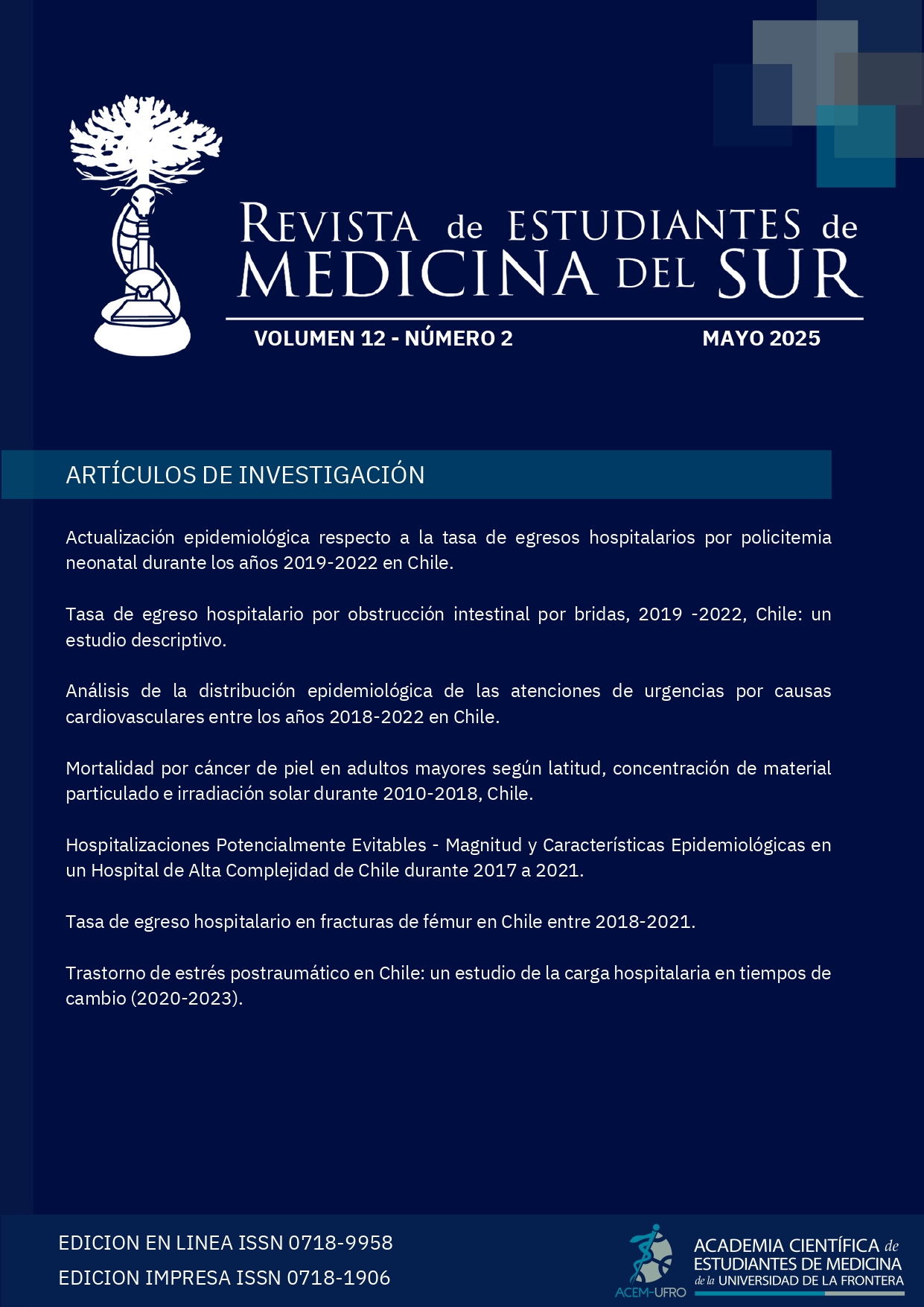Trastorno de estrés postraumático en Chile: Un estudio de la carga hospitalaria en tiempos de cambio (2020-2023)
Post-traumatic stress disorder in Chile: A study of hospital burden in times of change (2020-2023)
DOI:
https://doi.org/10.56754/0718-9958.2025.219Palabras clave:
Chile, Epidemiología, Hospitalización, Trastorno por estrés postraumático, PsiquiatríaResumen
Introducción:
El trastorno de estrés postraumático (TEPT) se caracteriza por síntomas como reexperimentación del evento traumático, hiperactivación fisiológica, evitación y alteraciones cognitivas. Debido a su alta prevalencia, se propone determinar la tasa de egreso hospitalario (TEH) por TEPT en el periodo 2020-2023 en Chile.
Materiales y métodos:
Estudio descriptivo, observacional y transversal. Se realizó un análisis descriptivo de la TEH por TEPT en pacientes mayores de 5 años en Chile durante el periodo 2020-2023, según las variables sexo, edad y estadía hospitalaria. Los datos fueron obtenidos desde el Departamento de Estadísticas e Información de Salud y del Instituto Nacional de Estadísticas, y se procesaron mediante Microsoft Office Excel. No se requirió evaluación por comité de ética.
Resultados:
Se analizaron 1.701 registros, determinando una TEH de 2,59 casos por cada 100.000 habitantes durante el periodo 2020-2023. Se observa un constante aumento en las tasas a lo largo del periodo. Destaca un predominio del sexo femenino y pacientes entre 15-19 años de edad. Se calculó un promedio de estadía hospitalaria de 16,45 días, con estadías más largas en hombres.
Discusión:
El aumento de las tasas podría explicarse como efecto post-pandemia asociado a baja disponibilidad de servicios psiquiátricos durante esta. El predominio femenino se asociaría a factores como la violencia de género, mientras que en adolescentes se relacionaría con su vulnerabilidad psicológica. Las diferencias en la estadía hospitalaria según sexo podrían estar relacionadas con la gravedad de los síntomas y acceso a redes de apoyo.
Conclusión:
Este estudio destaca la necesidad de fortalecer estrategias de prevención y tratamiento del TEPT, especialmente en mujeres y adolescentes, y de reducir las barreras de acceso para atención especializada en poblaciones subrepresentadas.
Citas
Becerra-Canales B, Campos-Martínez HM, Campos-Sobrino M, Aquije-Cárdenas GA. Trastorno de estrés postraumático y calidad de vida del paciente post-COVID-19 en Atención Primaria. Aten Primaria [Internet]. 2022;54(10):102460. Disponible en: http://dx.doi.org/10.1016/j.aprim.2022.102460
Morales Mesa SA, Agudelo Martínez MA, Berbesi Fernández DY. Prevalencia y factores asociados al trastorno de estrés postraumático en personas desplazadas en Colombia. CES Psicol [Internet]. 2021: 134–50. Disponible en: http://www.scielo.org.co/scielo.php?script=sci_arttext&pid=S2011-30802021000300134
Moreno Montenegro NV, Lema Caisaguano JM, Granda Cueva DC, Acosta Romo MF. Cuidado humanizado de enfermería para reducir el síndrome de estrés postraumático en pacientes hospitalizados en la unidad de cuidados intensivos. Rev Criterios [Internet]. 2023; 30(2):175–90. Disponible en: https://revistas.umariana.edu.co/index.php/Criterios/article/view/3525
Novo Navarro P, Landin-Romero R, Guardiola-Wanden-Berghe R, Moreno-Alcázar A, Valiente-Gómez A, Lupo W, et al. 25 años de Eye Movement Desensitization and Reprocessing: protocolo de aplicación, hipótesis de funcionamiento y revisión sistemática de su eficacia en el trastorno por estrés postraumático. Rev Psiquiatr Salud Ment [Internet]. 2018;11(2):101–14. Disponible en: http://dx.doi.org/10.1016/j.rpsm.2015.12.002
Crespo Generelo T, Camarillo Gutiérrez L, de Diego Ruiz H. Trastorno por estrés agudo y postraumático. Medicine [Internet]. 2019;12(84):4918–28. Disponible en: http://dx.doi.org/10.1016/j.med.2019.07.002
Contreras-Rodríguez J, Quintana-Cadillo A, Yacchi-Sarmiento A, Saavedra- Castillo J. Aspectos clínicos y factores asociados al estrés postraumático en pacientes adultos de tres ciudades de la sierra peruana. Rev Neuropsiquiatr [Internet]. 2022; 85(3):206–23. Disponible en: http://www.scielo.org.pe/scielo.php?script=sci_arttext&pid=S0034-85972022000300206
Bermúdez Durán LV, Barrantes Martínez MM, Bonilla Álvarez G. Trastorno por estrés postrauma. Rev Medica Sinerg [Internet]. 2020; 5(9):e568. Disponible en: https://revistamedicasinergia.com/index.php/rms/article/view/568
Agorastos A, Olff M. Sleep, circadian system and traumatic stress. Eur J Psychotraumatol. 2021 Sep 28;12(1):1956746. Disponible en: https://doi.org/10.1080/20008198.2021.1956746
Sareen, J. (2022). Posttraumatic stress disorder in adults: Epidemiology, pathophysiology, clinical features, assessment, and diagnosis. In UpToDate®. Wolters Kluwer.
Lang AJ, Hamblen JL, Holtzheimer P, Kelly U, Norman SB, Riggs D, Schnurr PP, Wiechers I. A clinician's guide to the 2023 VA/DoD Clinical Practice Guideline for Management of Posttraumatic Stress Disorder and Acute Stress Disorder. J Trauma Stress. 2024 Feb;37(1):19-34. Disponible en: https://doi.org/10.1002/jts.23013
Descargas
Publicado
Cómo citar
Número
Sección
Categorías
Licencia
Derechos de autor 2025 Matías Salinas Núñez, Constanza Saavedra Aedo, Verónica Córdova Rojas, Bryan Álvarez Michea, Enzo Álvarez Michea, Bárbara Mena González

Esta obra está bajo una licencia internacional Creative Commons Atribución-NoComercial-CompartirIgual 4.0.


